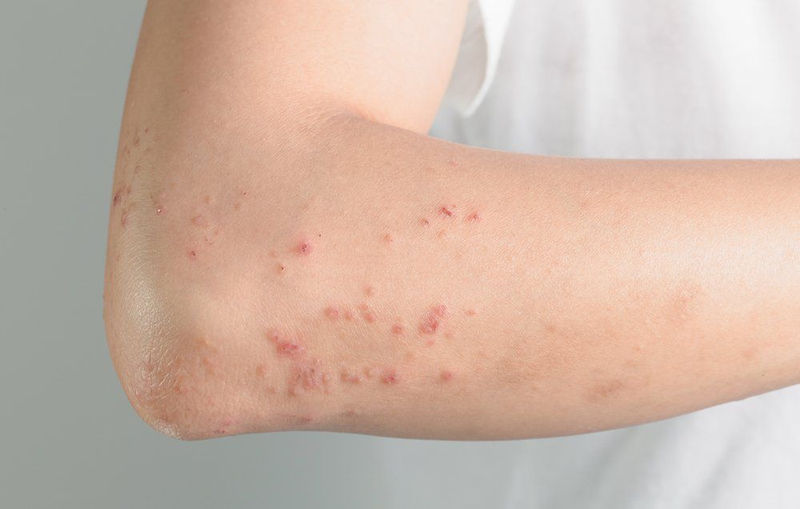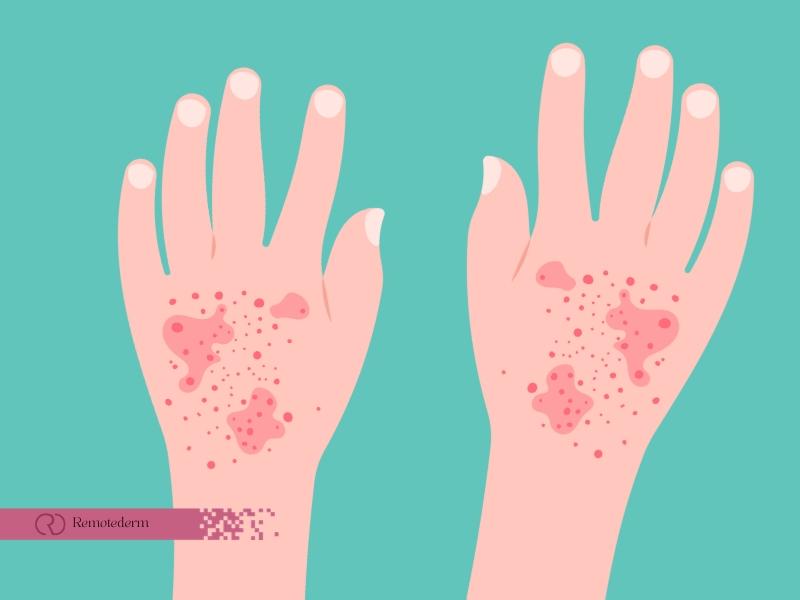Bullous Pemphigoid (BP) is a challenging autoimmune disorder that primarily affects the skin, leading to large fluid-filled blisters. This chronic condition, typically appearing in individuals around the age of 70, can significantly impact quality of life in Canada. In this in-depth guide, we explore the origins, symptoms, diagnostic methods, and treatment options for managing Bullous Pemphigoid, offering valuable insights for those affected by this condition.
What is Bullous Pemphigoid?
Bullous Pemphigoid is not merely a skin condition; it is a complex autoimmune blistering disorder that arises when the immune system, typically the body’s defender against external threats, turns against its own skin cells. This autoimmune response leads to the formation of characteristic fluid-filled blisters, medically termed bullae. These bullae, which are indicative of the condition, can appear on almost any part of the body. They do, however, prefer areas such as the arms, legs, and abdomen.
Causes of Bullous Pemphigoid
Aside from autoimmune responses, several factors are believed to contribute to the development of Bullous Pemphigoid:
Genetic Predisposition
There is evidence to suggest a genetic predisposition to BP. Certain genetic factors may increase an individual’s susceptibility to autoimmune reactions, heightening the risk of developing Bullous Pemphigoid.
Environmental Factors
Exposure to specific medications or chemicals is thought to contribute to the development of Bullous Pemphigoid. Certain environmental triggers may initiate or exacerbate the autoimmune response, resulting in blister formation.
Underlying Health Issues
Bullous Pemphigoid has been linked to a variety of other health issues, including neurological disorders and certain infections. This points to a complex interplay of factors in which these conditions may act as triggers or aggravate the autoimmune response.
Symptoms of Bullous Pemphigoid
Bullous Pemphigoid (BP) manifests with a range of distinctive symptoms, primarily characterized by the development of tense, fluid-filled blisters on the skin. The severity of symptoms can vary among individuals, but common clinical manifestations include:
- Blisters and Skin Eruptions: The hallmark symptom of BP is the formation of large, blistering lesions on the skin. These blisters are typically filled with clear fluid and are prone to rupture, leading to open sores.
- Itching (Pruritus): Patients with Bullous Pemphigoid often experience intense itching, which may precede the appearance of blisters. Scratching can exacerbate the condition and increase the risk of secondary infections.
- Red, Inflamed Skin: The areas surrounding the blisters may become red and inflamed, contributing to the overall discomfort associated with the condition.
- Mucous Membrane Involvement: In some cases, BP may affect mucous membranes, leading to blistering and erosions in the mouth, throat, or genital areas.
- Generalized Skin Rash: Beyond the blistering, a generalized skin rash may develop, affecting areas beyond the immediate vicinity of the blisters.

Bullous Pemphigoid vs. Hives
Bullous Pemphigoid and hives, though both skin conditions, differ significantly in their nature and manifestations. Bullous Pemphigoid is an autoimmune blistering disorder where the immune system mistakenly attacks the skin, leading to large, fluid-filled blisters. This chronic condition primarily affects older individuals and can cause intense itching. On the other hand, hives, or urticaria, are raised, red welts on the skin that result from an allergic reaction, stress, or other triggers. Unlike Bullous Pemphigoid, hives are typically acute and temporary, disappearing within hours or a few days. While both conditions involve skin abnormalities, their causes, durations, and underlying mechanisms diverge.

Diagnosis of Bullous Pemphigoid
Dermatologists and healthcare professionals typically follow a systematic approach to confirm the presence of Bullous Pemphigoid (BP) and differentiate it from other skin conditions. Diagnosing BP involves a combination of clinical evaluation, laboratory tests, and often skin biopsies:
- Clinical Evaluation: Diagnosis of Bullous Pemphigoid (BP) involves a comprehensive clinical assessment, including a thorough examination of the patient’s medical history and a close inspection of skin lesions. Characteristic tense blisters and itching are key indicators.
- Blood Tests: Laboratory tests are conducted to detect specific antibodies associated with BP, such as anti-BP180 and anti-BP230 antibodies. Elevated levels of these antibodies in the blood strengthen the diagnostic evidence.
- Skin Biopsy: A skin biopsy is a crucial step in confirming the diagnosis. This involves taking a small sample of affected skin for microscopic examination, revealing characteristic changes in the skin layers and immune system activity consistent with Bullous Pemphigoid.
- Collaborative Approach: Due to the complexity of BP, a collaborative approach involving dermatologists, immunologists, and pathologists may be necessary to ensure accurate diagnosis and appropriate management.
Treatment Options for Bullous Pemphigoid
The treatment of Bullous Pemphigoid (BP) aims to control symptoms, promote healing, and prevent complications associated with blistering and skin erosions. Various therapeutic approaches are employed, often tailored to the individual’s specific condition and medical history:
- Corticosteroids: Systemic corticosteroids, such as prednisone, are commonly prescribed to suppress the immune system’s overactive response. These medications effectively reduce inflammation and blister formation. However, long-term use may lead to side effects, necessitating careful monitoring.
- Topical Steroids: For localized cases, topical corticosteroids may be applied directly to affected areas to minimize inflammation and itching.
- Immunosuppressive Medications: In cases where corticosteroids alone are insufficient or pose risks, immunosuppressive drugs like azathioprine or mycophenolate mofetil may be prescribed to modulate the immune response.
- Rituximab: This monoclonal antibody therapy targets specific immune cells involved in the autoimmune process, offering an alternative for cases resistant to traditional treatments.
- Tetracycline and Nicotinamide: Antibiotics like tetracycline, often combined with nicotinamide, have shown efficacy in some cases, particularly in milder forms of BP.
Dermatological Advancement
With the advent of technology, remote dermatology services like RemoteDerm have gained prominence. This platform facilitates online consultations with dermatologists, providing a convenient and accessible means for individuals to receive expert advice and guidance, especially pertinent for chronic conditions like Bullous Pemphigoid. RemoteDerm enables patients to connect with dermatologists, share images of their skin condition, and receive personalized treatment recommendations from the comfort of their homes.

Living with Bullous Pemphigoid
Living with Bullous Pemphigoid (BP) in Canada poses both physical and emotional challenges, requiring individuals to navigate a chronic condition that impacts the skin’s integrity. Coping strategies and lifestyle adjustments are essential components of managing daily life with BP, helping those affected lead a more comfortable and balanced life while dealing with this condition.
Skin Care
Gentle skin care practices, including the use of mild soaps and moisturizers, are crucial to minimize irritation and reduce the risk of blistering. Regular monitoring for signs of infection is important.
Pain and Itch Management
The intense itching associated with BP can be managed with prescribed medications and cool compresses. Pain relief strategies may be incorporated to address discomfort, promoting a better quality of life.
Clothing Choices
Selecting loose-fitting, soft clothing can help prevent friction and reduce the risk of further skin trauma. It is recommended to avoid using tight fabrics and seams over affected areas.
Medical Follow-up
Regular check-ups with healthcare providers, including dermatologists, facilitate ongoing monitoring of BP progression and treatment effectiveness. Open communication about symptoms and concerns is vital for effective management.
Final Thoughts
Bullous Pemphigoid presents a multifaceted challenge in Canada, requiring a comprehensive approach to diagnosis and management. Dermatologists play a crucial role in guiding patients through this autoimmune disorder. As technology advances, platforms like RemoteDerm offer innovative solutions, making it easier for individuals to access specialized care.
In the ongoing journey to understand Bullous Pemphigoid, collaboration between patients, dermatologists, and emerging healthcare technologies is essential. Continued research will deepen our understanding of this rare skin disorder, leading to more effective treatments and improving the quality of life for those affected by Bullous Pemphigoid.
FAQs
1. Can environmental factors contribute to BP?
Yes, certain medications or chemicals are thought to contribute to the development of Bullous Pemphigoid.
2. Why is regular medical follow-up important in Bullous Pemphigoid?
Regular visits to healthcare providers, including dermatologists, aid in the monitoring of blood pressure progression and treatment effectiveness.
3. Why is early intervention crucial in BP?
Early intervention is essential for timely treatment, alleviating symptoms, minimizing complications, and improving overall patient outcomes.
4. Can emotional support benefit individuals with BP?
Yes, seeking support from friends, family, or support groups, and possibly engaging in counseling, can contribute to emotional well-being.
